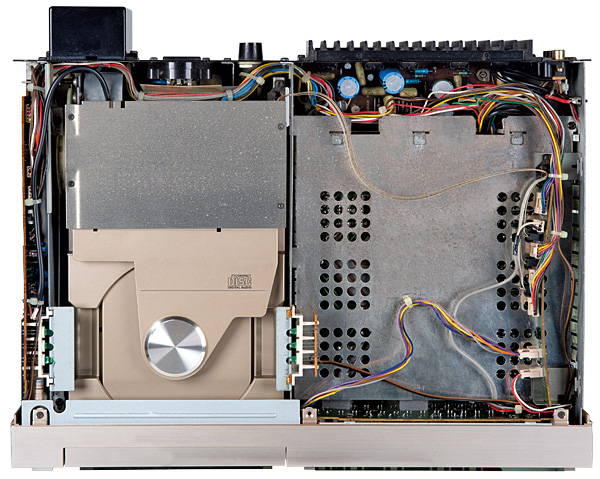Marantz CD-73 CD player Page 2
The track display LEDs are a little basic, the green ones showing the available tracks, the orange ones how far playback has progressed through them. Discs with more than 15 tracks have to be navigated 'blind' beyond this point, a small 'overflow' indicator lighting up to show when this is happening. In common with all early Philips designs, it is only possible to skip forwards through the disc, although the 'select' key can be used to choose any track, which will then be found on pressing 'play'.
![]() Tim Listens
Tim Listens
The sonic signature of any early Philips 14-bit CD player is unmistakable, being a combination of rich, plump bass and the subtle way in which sounds such as those from stringed instruments are handled. The CD-73 sounds immediately familiar in this respect: style the cabinet as you wish, but there can be no doubt who made the insides. Many pieces of music revealed these traits, including Dire Straits' Brothers In Arms [Vertigo 824 499-2] – a disc used by Philips at the time to demonstrate the strengths of digital recording.

Another revealing track was 'Learning To Fly' by Tom Petty And The Heartbreakers [from the compilation album Anthology; MCA 170 178-2], which can sound dry and lifeless when heard via unsympathetic equipment. Played on the CD-73, the bass line thudded away under the rest of the music in a way that was most satisfying while guitars twanged and percussion twinkled over the top, all polished up by the black magic of 4x oversampling and digital filters.
These early Philips designs remain an exceptionally accessible way to enjoy CD recordings. Relaxed-sounding and fluid, the rather overused cliché that they sound a bit like vinyl (but without the clicks and pops) isn't that wide of the mark. Heard in isolation, then, this Euro-Oriental hybrid sounds like any other 14-bit Philips machine. However, under the microscope of an A/B comparison with a Philips CD303 having SAA7020 and SAA7000 chips on board, some small differences can be discerned.
The overall tonality remains unchanged, but there is a slight variation in the character of the treble. The Marantz player has a harder edge (no bad thing it could be said, the standard Philips being a bit soft for some tastes). For example, the CD-73 lifts the sibilance by a fraction in the voice of Tori Amos as she sings 'Crucify', the opening track of her album Little Earthquakes [East West 7567-82358-2]. The standard CD303 does not.
Truth And Consequences
Play music that's rich with positional information, such as the song 'Fascination' by Everything But The Girl [from the compilation Home Movies; Blanco y Negro 4509 92319 2], and here it could be argued that the solidity of the guitar line in the overall soundstage is a tad more diffuse when heard on the Marantz CD-73. However, since these differences are only really detectable if you have both versions of the machines side by side for comparison, I'm tempted to say that they are of no real consequence in real-world listening. In whatever form it comes, the Marantz CD-73 is a fine player and unquestionably worthy of the high esteem in which it is held.
Buying Secondhand
Like all the early Philips players, the CD-73 benefits from having a durable optical unit that rarely gives any trouble. Since worn lasers are a common problem with many vintage CD players, and one that can be difficult to resolve, this is a real boon. It isn't all plain sailing though, as poor soldering is a common fault throughout the CD-73, particularly around the display, the voltage regulators and the flexible cables that run between the drawer and the main chassis.

There are two 100µF electrolytic capacitors in a voltage doubler circuit in the power supply that will almost certainly require replacing by now if they are the original ones. The smaller components of the same type both here and on the panel, which controls the drawer, are also suspect in well used examples, but this shouldn't be taken as an excuse to change them all. The types used on the two main printed circuits inside the screening can are of good quality and are best left alone.
Reluctance to spin a disc, especially after a period of disuse, points to hardened lubricants in the spindle motor, particularly if a CDM0 transport is fitted to the player. There isn't much that one can do about this, but with persistence the machine will usually start working once more and continue to do so until it is laid up again.
The TDA1540 DAC chips can sometimes play up, giving distorted sound in one or other channel (sometimes only when the player is warm). Later models, such as the Philips CD150 and 350 can provide a useful source of replacement parts in cases like this. Not only do they share much in common but are still cheap and plentiful.
Finally, the blue 'Compact Disc' logo on the front of the CD-73 can often fail to illuminate. It may look like an exotic device, but behind it is nothing more than a filament lamp. Replacement is straightforward, even if the dismantling required to reach it is not.
Hi-Fi News Verdict
The CD-73 deserves its position as one of the most desirable early CD players. Visually striking, durable and a joy to listen to, it's a perfect addition to a vintage system for those seeking to broaden the range of media that can be played. The machines are in good supply, so be selective and don't pay over the odds, and are tough enough for everyday use – something you'll want to do once you hear a good one.
























































